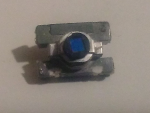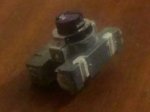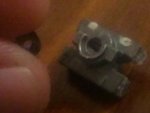Hey, I have recently been making a few lasers in my shed using diodes from dvd drives and since I'm new to lasers and electronics I wanted to ask a few questions regarding electrical power as well as some specific questions about red laser diodes, sorry if this post is a bit long but I don't want to leave out any important info. Please feel free to just skip to question 4 as that doesn't require reading the paragraph below.
I have always been fairly certain that Power = Voltage X Current
Now here are some details about my laser. I am currently using Samsung 24x DVD Writer desktop drive diodes (originally extracted from brand new DVD drives) and these diodes have a big rectangular laser housing with an unusual look very much resembling a camera lens, they look much bigger than any other dvd laser diode I've seen. I've extracted a few different types and selected the Samsung diode since it stands up to the most current before dying. I am running my laser device as follows:
I'm using a home made driver utilising an LM317T, a few resistors, a pot, a capacitor and 2 N4004 diodes. I got the driver schematics from a youtube video. I am powering my home made device with 2 Li-Ion Cells in series giving 8.4V when fully charged. I have set the current of each driver to 400mA. There are several laser diodes on this device (all Samsung) and a driver for each diode with drivers connected to power source in parallel. I have checked and each diode receives 400mA @ 7.2V during operation as supplied by their drivers. I have been using this device for over 3 months now on a daily basis as it actually serves as a very useful tool which does a far better job than any alternative I have found. I would estimate that it is on for 200 seconds per day with duty cycles under 10 seconds. The diodes don't get hot nor warm at any time during operation.
Now with the above in mind here are my questions.
1) How much power is each diode drawing. Is it simply, 0.4A x 7.2V = 2.88W ???
2) I would like to have an idea of the light power output of this laser device. From what I have been able to gather the red laser diodes tend to be the most efficient. To my best knowledge these Samsung diodes have a conversion efficiency of anywhere from 20% to 30%. Please someone correct me if I'm wrong. Assuming the efficiency is 25%. Would the total light output of each diode simply be, 0.25 x 2.88W = 720mW ??
3) Do you think that I'm pushing these diodes too hard with 400ma @ 7.2V ?
So far after 3 months consistent use they are just as bright as the day I extracted them from brand new drives.
4) Do DVD 650nm red laser diodes put out only or mostly red light or are other wavelengths significantly present in the light output of the diode? I am mostly concerned about infrared being present and wouldn't mind if higher frequency visible light were present in the output but I'd still like to know if it is.
Thanks so much in advance for any responses.
I have always been fairly certain that Power = Voltage X Current
Now here are some details about my laser. I am currently using Samsung 24x DVD Writer desktop drive diodes (originally extracted from brand new DVD drives) and these diodes have a big rectangular laser housing with an unusual look very much resembling a camera lens, they look much bigger than any other dvd laser diode I've seen. I've extracted a few different types and selected the Samsung diode since it stands up to the most current before dying. I am running my laser device as follows:
I'm using a home made driver utilising an LM317T, a few resistors, a pot, a capacitor and 2 N4004 diodes. I got the driver schematics from a youtube video. I am powering my home made device with 2 Li-Ion Cells in series giving 8.4V when fully charged. I have set the current of each driver to 400mA. There are several laser diodes on this device (all Samsung) and a driver for each diode with drivers connected to power source in parallel. I have checked and each diode receives 400mA @ 7.2V during operation as supplied by their drivers. I have been using this device for over 3 months now on a daily basis as it actually serves as a very useful tool which does a far better job than any alternative I have found. I would estimate that it is on for 200 seconds per day with duty cycles under 10 seconds. The diodes don't get hot nor warm at any time during operation.
Now with the above in mind here are my questions.
1) How much power is each diode drawing. Is it simply, 0.4A x 7.2V = 2.88W ???
2) I would like to have an idea of the light power output of this laser device. From what I have been able to gather the red laser diodes tend to be the most efficient. To my best knowledge these Samsung diodes have a conversion efficiency of anywhere from 20% to 30%. Please someone correct me if I'm wrong. Assuming the efficiency is 25%. Would the total light output of each diode simply be, 0.25 x 2.88W = 720mW ??
3) Do you think that I'm pushing these diodes too hard with 400ma @ 7.2V ?
So far after 3 months consistent use they are just as bright as the day I extracted them from brand new drives.
4) Do DVD 650nm red laser diodes put out only or mostly red light or are other wavelengths significantly present in the light output of the diode? I am mostly concerned about infrared being present and wouldn't mind if higher frequency visible light were present in the output but I'd still like to know if it is.
Thanks so much in advance for any responses.
Last edited:









